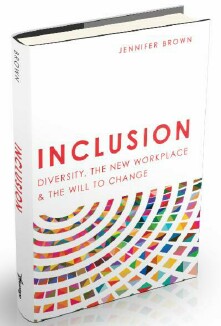A New Excerpt from Inclusion: Diversity, the New Workplace & the Will to Change

Jennifer Brown is an award-winning entrepreneur, dynamic speaker and diversity and inclusion expert. Informed by more than a decade consulting to Fortune 500 companies, her new book entitled Inclusion: Diversity, the New Workplace & the Will To Change (Advantage Media Group, November Fall 2016) creates a compelling case for leadership to embrace the opportunity that diversity represents, for their own growth and for the success of their organizations, while simultaneously empowering advocates at all levels to find their voice and be a driving force in creating more enlightened organizations that resonate in a fast-changing world. Below, we present a third excerpt from this relevant book, which is now more timely than ever. Be sure to read the first and second excerpts recently published here at MediaVillage.com.
The book Lean In by Sheryl Sandberg, COO of Facebook, made tremendous waves when it was published in 2013. It was a clear call from a successful woman to other women mainly about managing their careers more intentionally, more boldly, and paying attention differently to the rules of the game. I appreciated Sandberg’s call to step up, not to play small, and not to hesitate in negotiating salary or moves up the ladder.
In her TED Talk, Sandberg described how women unintentionally hold themselves back in their careers and urged them to be fearless and bold. She expanded upon these ideas in Lean In: “Women need to shift from thinking, I’m not ready to do that,to thinking, I want to do that -- and I’ll learn by doing it.” I would define the restraint or “I’m-not-ready-ness” as the collateral impact of stories we tell ourselves about our worth, our value and our ability to lead, as well as the messages we receive from the wider culture; it’s connected to the stereotype threat we have grown up with as girls, and now women trying to make it in the business world.
our ability to lead, as well as the messages we receive from the wider culture; it’s connected to the stereotype threat we have grown up with as girls, and now women trying to make it in the business world.
Sandberg laid a tremendous amount of responsibility for women’s slow advancement on women themselves, and while the book was widely lauded, there was also a backlash from women who did not share Sandberg’s relative privileges as a starting point. It’s a lot easier to lean in to the discussion if you are already at the table, if you are already in the room, and if you enjoy relative privilege in terms of your ethnicity, your education and your socio-economic background.
Women do need training and mentoring in order to rewrite their narratives so that they can move forward with intention, but as I hope I have made clear by now, organizations must equally participate in and prioritize inclusion and opportunity from the top. Women showing up differently can have adverse effects if those like her, and her senior leadership, aren’t ready to provide steadfast support.
Sandberg herself acknowledges the structural inequities and bias when she writes, “Success and likeability are positively correlated for men and negatively for women. When a man is successful, he is liked by both men and women. When a woman is successful, people of both genders like her less.” While the onus is on all of us to rewrite this narrative -- a tall order -- there is a critical part for top leadership to play in elevating female role models up the hierarchy, lauding their successes and providing air cover for them to show up powerfully without being subject to a double standard.
The ancillary workstream to the message for women to modify their approach is, of course, to call for change in the system affecting women. It is fascinating to me that we’ve assumed all of our business cases, our data, our case studies, our HBR articles, and so on, will be enough to convince our organizations and their leadership that change is needed -- without enlisting those very leaders as real partners. Successful movements for equality have often turned a critical corner when those outside the demographic who need the most supportstep forward to learn more, to challenge their assumptions, and to advocate and push forward on the behalf of that demographic. In the diversity context, a largely white and male executive suite in so many companies is precisely the audience we need to proactively include.
There are -- and I know some of them -- male champions in our midst, hailing from that majority whose participation we so badly need. We must focus on arming our early adopters in the majority with the facts to understand the problem, help them over the hurdle of the inalienable fact that they haven’t experienced the same headwinds, and then lay out a plan for action with them as full partners.
There is no single way to make change happen; companies need a whole ecosystem of measures. But shifting our mindset to focus on those who haven’t, traditionally, participated in the dialogue would certainly get us further, faster. We can’t afford to leave such a powerful resource on the table.
Click the social buttons above or below to share this content with your friends and colleagues.
The opinions and points of view expressed in this article are exclusively the views of the author and/or subject(s) and do not necessarily represent the views of MediaVillage.com/MyersBizNet, Inc. management or associated bloggers.


